Explore Ha Long - North Vietnam Travel, Asia
Nestled in Quang Ninh Province, the northeastern region of Vietnam, Ha Long stands as a mesmerizing jewel in the crown of the country's tourism landscape. Famous for its emerald waters and thousands of towering limestone islands topped with rainforests, Ha Long natural beauty attracts millions of visitors each year. Whether you're seeking adventure, relaxation, or cultural exploration, Ha Long offers an array of experiences that promise to captivate and inspire. From its breathtaking natural beauty to its rich cultural tapestry, Ha Long is a destination that beckons travelers from all corners of the globe.
Population: Approximately 270,000 in 2019.
Economy: Capital city of Quang Ninh Province, Ha Long economy is divided into 5 distinct sections that allow the city to be one of the fastest growing metropolitan areas in Northern Vietnam.
Landmarks: Famous for Ha Long Bay, Tuan Chau Island, and Cat Ba Island.
Vietnam

Overview of Ha Long
History & Cultural Influence
Ha Long's history is as deep and mysterious as its famed bay. The name "Ha Long" means "Descending Dragon," rooted in ancient legends where dragons descended to protect the Vietnamese from invaders. This rich historical heritage is woven through various archaeological sites and ancient relics found in the area. Culturally, Ha Long is a melting pot influenced by its strategic coastal location. It has seen the merging of Vietnamese traditions and foreign influences over centuries, from ancient trading routes to colonial periods. This blend is evident in the architecture, local festivals, and even in the cuisine, where traditional Vietnamese dishes are often infused with a unique twist.
Interaction with the Locals
Ha Long, located in the northeastern part of Vietnam, is home to approximately 270,000 residents. The city's population is diverse, comprising various ethnic groups, including the Kinh, Tay, and Dao. The people of Ha Long are known for their warm hospitality and strong ties to traditional customs. The local community primarily engages in fishing, tourism, and services, reflecting the region's rich natural and cultural heritage. This blend of traditions and modernity makes Ha Long a vibrant and welcoming destination for visitors.
For all our Vietnam tours, we provide passengers with 24/7 local support with highly experienced guides. Check out our premium tours to Vietnam here.
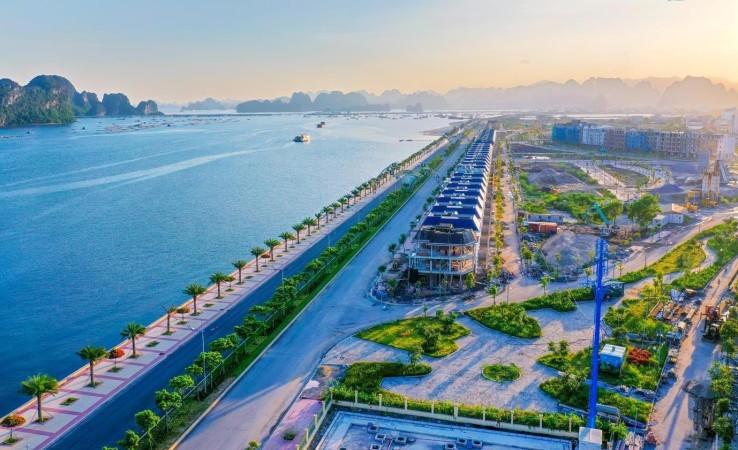
Ha Long city - © CafeBiz
Top Attractions in Ha Long
Ha Long is the crown jewel of the region, known for its iconic Ha Long Bay limestone karsts that rise dramatically from the emerald waters. Each attraction offers a unique glimpse into the natural and cultural beauty of Ha Long, ensuring that every traveler finds something to marvel at.
Ha Long Bay: The heart and soul of the region, Ha Long Bay is famed for its emerald waters and over 1,600 towering limestone islands and islets. Every island is different, with morphologies and topography that give rise to many myths. A boat tour is the best way to experience this UNESCO World Heritage Site. Options range from half-day trips to multi-day cruises that include activities like kayaking, cave exploration, and night fishing.
Bai Tu Long Bay: Just northeast of Ha Long Bay, Bai Tu Long Bay offers a quieter, more secluded alternative. This area is less frequented by tourists, making it perfect for those seeking coastal retreats. The scenery here is just as stunning, with pristine beaches, crystal-clear waters, and fascinating limestone karsts. Boat tours and kayaking trips allow for intimate encounters with this serene landscape.
Cat Ba Island: The largest island in Ha Long Bay, Cat Ba Island is a haven for adventure enthusiasts and nature lovers. The island is home to Cat Ba National Park, a UNESCO Biosphere Reserve. The park boasts lush forests, diverse wildlife, and challenging hiking trails. Visitors can also explore the island’s rugged coastline, enjoy water sports, or relax on one of its many beautiful beaches.
Tuan Chau Island: As the gateway to Ha Long Bay, Tuan Chau Island is a vibrant tourist hub. The island is known for its luxurious resorts, entertainment complexes, and a wide array of recreational activities. Visitors can enjoy water sports, dine at seaside restaurants, or relax on sandy beaches. Traditional Vietnamese water puppet displays are among the cultural events and performances that take place on the island.
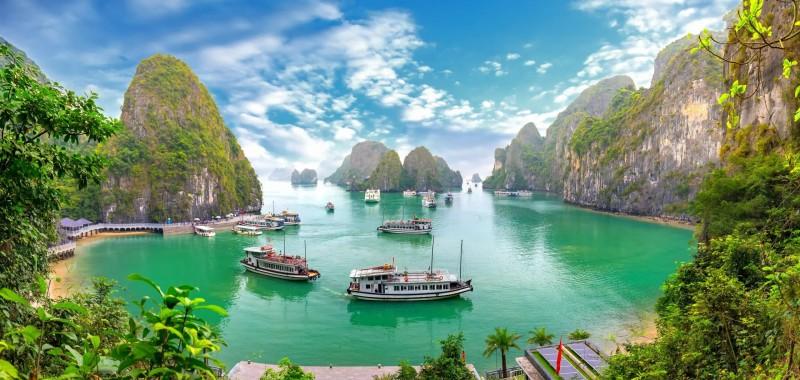
Ha Long Bay - © VietnamNet
Must-Try Dishes in Ha Long
Ha Long is not only a feast for the eyes but also for the palate. The region's cuisine is rich and varied, heavily influenced by its coastal location. Seafood is the star of the culinary scene, with fresh catches prepared in a variety of delicious ways. These dishes are a testament to Ha Long's rich culinary traditions, showcasing the region's fresh seafood and vibrant flavors. Don't miss the opportunity to explore local markets and eateries to taste these and other regional delights.
- Cha Muc Ha Long (Ha Long Squid Sausages): One of Ha Long's signature dishes, Cha Muc is made from fresh squid, finely ground and mixed with spices, then shaped into sausages or patties and deep-fried. The result is a savory, slightly chewy delight that pairs perfectly with sticky rice or steamed rice cakes.
- Ngao dishes (Clams dishes): A distinctive seafood delicacy, Ngao clams are found in the waters around Ha Long. They are often steamed, grilled, or cooked in a hotpot. The clams have a sweet and rich flavor, and their versatility allows them to be enjoyed in a variety of dishes, from soups to stir-fries.
- Bun Be Be (Noodle Soup with Be Be Shrimp): This noodle soup features a unique ingredient: Be Be shrimp, a small, tasty crustacean native to Ha Long Bay. The shrimp are cooked in a flavorful broth with rice noodles and herbs, creating a dish that is both refreshing and satisfying.
- Sam dishes (Horseshoe Crab dishes): Another local specialty, horseshoe crabs are prepared in several ways in Ha Long. Popular dishes include grilled horseshoe crab and horseshoe crab salad. The meat is sweet and tender, often flavored with a tangy, spicy sauce that highlights the seafood's natural taste.
- Gat Gu Cake (Ha Long's Sweet Black Rice Cake): This traditional Ha Long treat is made from black glutinous rice, coconut milk, and sugar, and is typically served with a sprinkle of sesame seeds. Its rich, sweet flavor and chewy texture make it a delightful end to any meal.
Explore many more tasty dishes in southern Vietnam, and enjoy the seafood in Nha Trang with our article here.
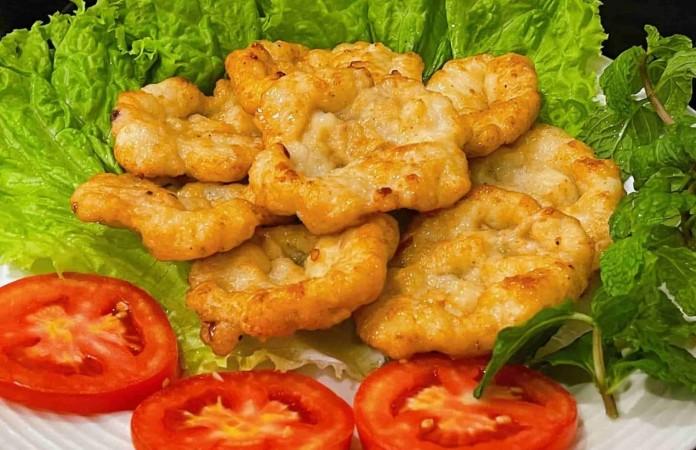
Cha Muc Ha Long (Ha Long Squid Sausages) - © Vietnam Tourism
Festivals & Local Celebrations
Ha Long is a vibrant cultural hub where traditional festivals and celebrations play a vital role in community life. These events offer a window into the region's rich heritage and provide visitors with unique and memorable experiences.
- Ha Long Carnival: The Ha Long Carnival, which is one of the most eagerly awaited events of the year, usually takes place in late April or early May. This lively festival features a colorful parade, elaborate costumes, music, dance, and fireworks. It celebrates the cultural diversity and vitality of Ha Long, attracting thousands of locals and tourists alike.
- Quan Lan Festival: Held in the Quan Lan Island area, this festival commemorates the historic victory of the Tran Dynasty over Mongol invaders in the 13th century. The festivities include traditional boat races, folk games, and cultural performances, reflecting the island's rich history and maritime heritage.
- Cua Ong Temple Festival: This festival takes place at Cua Ong Temple, dedicated to General Tran Quoc Tang, a national hero. Every year, it is held between the third and seventh lunar months. The festival features processions, traditional rituals, and performances that honor the general's contributions to the region's history.
- Yen Tu Festival: Although not directly in Ha Long, the nearby Yen Tu Mountain hosts a significant festival that attracts many visitors. The first day of the first lunar month marks the start of the three-month-long Yen Tu Festival. It is a spiritual journey for many Buddhists, who come to pay homage and seek blessings at the sacred mountain.
Weather in Ha Long: Best Time to Visit
Ha Long experiences a tropical monsoon climate, characterized by distinct wet and dry seasons. Knowing the patterns in the weather might help you choose the best time to visit.
Dry Season in Ha Long
The ideal time of year to visit Ha Long is regarded as the dry season. Throughout these months, the temperature is cooler and more comfortable, with highs between 15°C and 25°C (59°F and 77°F). The bay's limestone karsts are beautifully viewed from the bright skies that prevail most of the time, which makes it the perfect place for outdoor pursuits like hiking, sailing, and sightseeing. The months of March and April, in particular, are popular for their pleasant weather and blooming flowers.
Wet Season in Ha Long
The wet season brings higher temperatures and increased humidity, with temperatures ranging from 25°C to 35°C (77°F to 95°F). This period sees frequent rainfall, sometimes accompanied by typhoons. While the rain can add a mystical ambiance to the bay, it can also lead to cancellations of boat tours and other outdoor activities. However, this off-peak season often means fewer tourists and lower prices, which can be appealing for budget-conscious travelers.
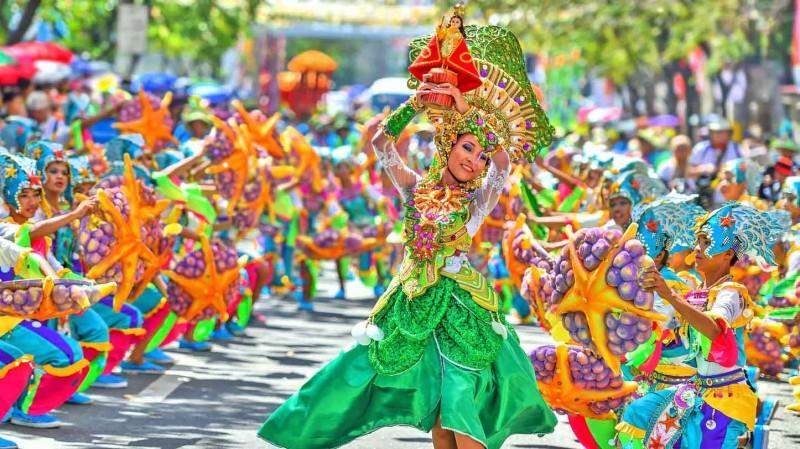
Ha Long Carnival - © Tan Thoi Dai
What to Do in Ha Long
Ha Long offers a wide range of activities that cater to all types of travelers, from adventure seekers to those looking for relaxation. These activities offer something for everyone, whether you're looking to relax and soak in the scenery or dive into exciting adventures.
- Ha Long Boat Tours and Cruises: Exploring Ha Long Bay by boat is an essential experience. Cruises range from luxury liners to traditional wooden junks, offering various packages that include sightseeing, dining, and overnight stays. These cruises often feature activities such as cave exploring, kayaking, and even cooking classes.
- Kayaking and Water Sports: For those who love water sports, Ha Long Bay is a paradise. You may get up close and personal with the bay's secret lagoons, caverns, and floating towns by kayaking across its tranquil waters. Other popular water activities include snorkeling, scuba diving, and jet skiing.
- Hiking and Exploring Caves: Ha Long's rugged landscape is perfect for hiking and caving adventures. The Cat Ba National Park offers several trails that lead to breathtaking viewpoints and diverse ecosystems. The Cat Ba langur, an endangered species, also resides in the park.
- Nightlife and Entertainment: While Ha Long is more famous for its natural beauty, it also has a growing nightlife scene. Tuan Chau Island is a popular spot for evening entertainment, with bars, restaurants, and live music. The city also offers cultural shows, such as traditional water puppet performances and folk music events.
Shopping in Ha Long
Shopping in Ha Long provides a delightful mix of local crafts, souvenirs, and modern conveniences. The region offers various markets and shopping centers where you can find unique items and gifts to take home.
- Local Markets: Ha Long's local markets are bustling hubs of activity where you can immerse yourself in the local culture. Ha Long Night Market is particularly popular, offering a wide range of products, from handmade crafts to clothing and fresh seafood. This market is an excellent place to find souvenirs like handcrafted jewelry, traditional embroidery, and ceramic items.
- Ha Long Fish Market: These markets are great spots for finding local specialties and fresh produce. Ha Long Fish Market is a must-visit for seafood lovers, where you can find an array of fresh and dried seafood, including fish, squid, and shrimp.
- Shopping Centers: For a more modern shopping experience, Ha Long offers several shopping centers like Ha Long Vincom Plaza and Big C Ha Long. These centers feature a variety of international and local brands, electronics, and fashion stores, providing a more upscale shopping experience.
- Unique Crafts and Products: Ha Long is known for its distinctive pearls, cultured in the waters of the bay. You can find beautiful pearl jewelry at various shops and markets. Additionally, coal sculptures and lacquerware are popular souvenirs, reflecting the region's rich natural resources and craftsmanship.
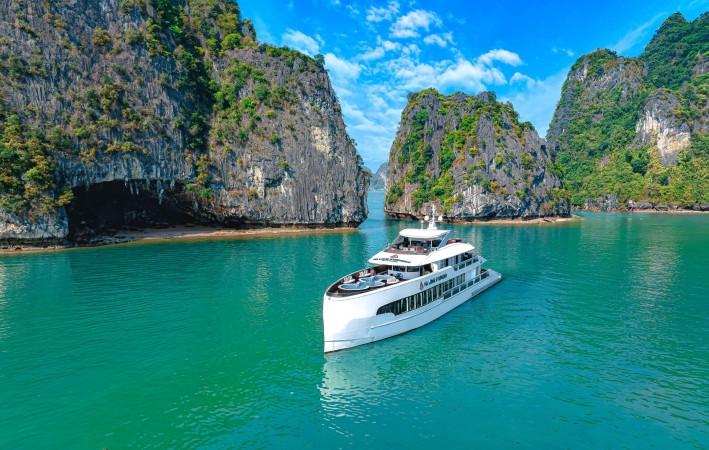
Ha Long Boat Tours - © HaLong Tourism
Cultural Etiquette in Ha Long
When visiting Ha Long, understanding and respecting local customs and cultural etiquette will enhance your experience and ensure a positive interaction with the locals.
- Dress Modestly: While Ha Long is a popular tourist destination, it’s important to dress modestly, especially when visiting temples or rural areas. Wearing clothes that expose your shoulders and knees is not a good idea. Fabrics that are breathable and lightweight are perfect for the warm weather.
- Respect Local Traditions: Ha Long has a rich cultural heritage, and many locals are deeply rooted in their traditions. When visiting temples or participating in local ceremonies, be respectful and follow the lead of local practices.
- Communication and Gestures: The Vietnamese people are generally warm and friendly. A small gesture of welcome, like a smile or a nod, is appreciated. It’s polite to use both hands when giving or receiving items, especially when handing over money or gifts.
- Tipping: Although it's not customary in Vietnam, tipping is valued in the travel and service sectors. If you receive excellent service, consider leaving a small tip as a gesture of appreciation. However, tipping is not obligatory, and you should not feel pressured to tip.
- Bargaining: Bargaining is common in local markets and small shops, especially when purchasing souvenirs or local goods. However, it should be done politely and with a friendly attitude. Start by offering a price lower than what you are willing to pay and gradually negotiate to a mutually agreeable amount.
Essential Travel Information
Getting Around Ha Long
Ha Long offers a variety of transportation options to explore the city and its attractions. Well-connected to major cities like Hanoi, the city is located about 170 kilometers away, with travel options including buses, private cars, and shuttle services. A seaplane service also offers a quicker and scenic route, providing breathtaking aerial views of the bay. Local transportation includes widely available taxis, motorbike taxis (xe om), and an affordable public bus system connecting major areas. Boat tours are a must-do for exploring Ha Long Bay, with options ranging from budget-friendly to luxury cruises. For those preferring more independence, bicycle and motorbike rentals are available, though it's important to wear a helmet and adhere to local traffic rules.
Check out Hoa Binh, a nearby popular city in Vietnam that you can reach out to when visiting Ha Long in this article.
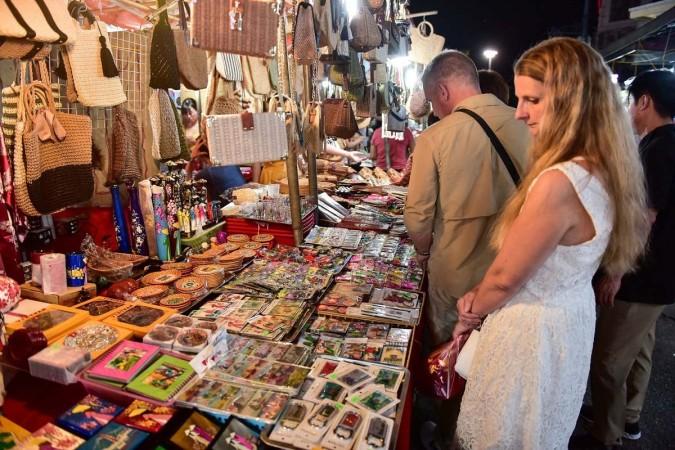
Wandering around Ha Long night market - © Vietnam Tourism
ATM & Banking Services
Access to banking services and ATMs in Ha Long is straightforward, allowing travelers to manage their finances easily. ATMs are plentiful in tourist areas, shopping centers, and major hotels, accepting international credit and debit cards such as Visa, MasterCard, and JCB. It’s wise to carry some cash for smaller shops and markets that may not accept cards. Several banks in Ha Long provide services including currency exchange, cash withdrawals, and international money transfers. Credit cards are generally accepted in mid-to-high-end establishments, but having a mix of payment options is advisable for smaller businesses and local markets.
Where to Stay in Ha Long
Ha Long has a large selection of lodging choices to suit different tastes and price ranges. Visitors can choose from high-end resorts and hotels with stunning views of Ha Long Bay, complete with premium amenities such as spas and fine dining, to mid-range hotels that provide a comfortable stay at reasonable prices. Budget travelers can find clean and basic accommodations in budget hotels and hostels, conveniently located near major attractions and public transport. For a more authentic experience, homestays offer a chance to immerse in local culture and interact with residents. Unique options like boat stays and eco-lodges to help promote sustainable tourism and preservation efforts.
Articles for you

Explore Yala National Park - Sri Lanka Travel, Asia
Tucked away in Sri Lanka’s southeastern corner, Yala National Park is where wild nature meets deep tradition. Known worldwide for its leopard population, the park is also home to elephants, sloth bears, crocodiles, and hundreds of bird species. Beyond wildlife, Yala opens doors to a cultural landscape dotted with ancient temples, Buddhist ruins, and coastal villages. For travelers seeking more than just a safari, Yala offers a chance to explore eco-tourism, local communities, and sacred heritage sites.
Population: The Yala National Park area doesn’t have a human population.
Economy: The economy around Yala National Park thrives on a blend of eco-tourism, agriculture, and local services. Safari tours, eco-lodges, and cultural experiences drive steady income for nearby towns like Tissamaharama and Kataragama, supporting thousands of families.
Landmarks: Famous for Block I of Yala and wildlife encounters, including elephants, sloth bears, crocodiles, and exotic bird species.

Explore Galle - Sri Lanka Travel, Asia
Nestled on Sri Lanka’s southern coastline, Galle is a vibrant city where history meets the sea. Its cobbled streets, colonial architecture, and serene beaches make it a must-visit destination for travelers seeking a blend of culture, adventure, and relaxation. A UNESCO World Heritage site, Galle captivates visitors with its Dutch Fort, bustling markets, and friendly locals. Whether you’re exploring the ramparts at sunset or savoring fresh seafood by the shore, Galle promises an unforgettable journey into Sri Lanka’s heritage.
Population: Approximately 113,000 in 2023.
Economy: Galle’s economy thrives on tourism, trade, and fisheries. The city’s historic fort, colonial architecture, and coastal charm draw thousands of international visitors each year, making tourism its main economic driver. Fishing remains vital for local livelihoods, supplying fresh seafood across the region.
Landmarks: Famous for the Galle Fort, Dutch Reformed Church & Maritime Museum, and Unawatuna Beach.

Explore Bentota - Sri Lanka Travel, Asia
Nestled along Sri Lanka’s southwestern coast, Bentota is a tropical paradise that blends golden beaches, vibrant culture, and thrilling adventures. Famous for its calm waters, luxury resorts, and scenic river estuary, Bentota has become a top destination for travelers seeking both relaxation and authentic experiences. From serene beach walks at sunrise to adrenaline-pumping water sports, this coastal town offers a perfect balance of leisure and exploration. With its proximity to Colombo and Galle, Bentota is easy to reach, making it an ideal stop for both short escapes and extended holidays.
Population: Approximately 37,000 in 2023.
Economy: Bentota’s economy thrives mainly on tourism, which drives local businesses such as hotels, restaurants, and wellness retreats. The town also benefits from fishing, coconut cultivation, and handicrafts like wood carving and batik textiles. Many residents rely on the growing demand for water sports and Ayurvedic treatments, making tourism the backbone of both income and employment in the area.
Landmarks: Famous for Bentota Beach, Bentota River Safari, and Kande Vihara Temple.

Explore Mirissa - Sri Lanka Travel, Asia
Mirissa is a charming coastal town on Sri Lanka’s southern shoreline. Known for its golden beaches, turquoise waters, and vibrant marine life, it has become a must-visit stop for travelers exploring the island. Many come for whale watching, surfing, and sunset views at Coconut Tree Hill, but Mirissa offers much more than postcard beauty. The fishing boats you see anchored by the bay carry generations of stories. Local traditions, delicious cuisine, and a laid-back rhythm of life shape every visitor’s experience.
Population: Approximately 4,700 in 2023.
Economy: Mirissa’s economy is largely shaped by its coastal location. Fishing has long been the backbone of local livelihoods, with generations relying on the Indian Ocean for income. In recent decades, tourism has become the main driver of growth, thanks to whale watching, surfing, and beachside hospitality.
Landmarks: Famous for Mirissa Beach, Coconut Tree Hill, and Parrot Rock Bridge.

Explore Nuwara Eliya - Sri Lanka Travel, Asia
Tucked away in the Central Highlands of Sri Lanka, Nuwara Eliya is often called “Little England”. With its rolling tea plantations, cool misty mornings, and colonial charm, this mountain town feels like a step into another world. Travelers come here to breathe fresh air, walk through flower gardens, sip the finest Ceylon Tea, and enjoy a pace of life far from the island’s busy cities. Whether you’re drawn by scenic landscapes, heritage architecture, or the warmth of its people, Nuwara Eliya is a destination that blends nature, culture, and history in perfect harmony.
Population: Approximately 781,000 in 2023.
Economy: Nuwara Eliya’s economy thrives mainly on tea production, as it sits in the heart of Sri Lanka’s central highlands, famous worldwide for Ceylon Tea. The city also benefits from a growing tourism industry, attracting visitors with its colonial charm, cool climate, and scenic landscapes.
Landmarks: Famous for Gregory Lake, Hakgala Botanical Garden, and Victoria Park.

Explore Sukau - Malaysia Travel, Asia
Nestled on the banks of the Kinabatangan River in Sabah, Malaysian Borneo, Sukau is a destination where wildlife, culture, and conservation come together. Known as one of Asia’s top spots for river safaris and eco-tourism, this quiet village offers a front-row seat to encounters with Bornean orangutans, pygmy elephants, proboscis monkeys, and exotic birdlife.
Population: Approximately 1,400 in 2019.
Economy: Sukau’s economy is shaped by its riverine location and natural resources. Traditionally, the Orang Sungai community relied on fishing, small-scale farming, and forest gathering for their livelihood. Today, the village has shifted toward eco-tourism, with river cruises, jungle trekking, and homestays providing income.
Landmarks: Famous for the Kinabatangan River cruises, Gomantong Caves, and Ox-bow lakes and wetlands.
